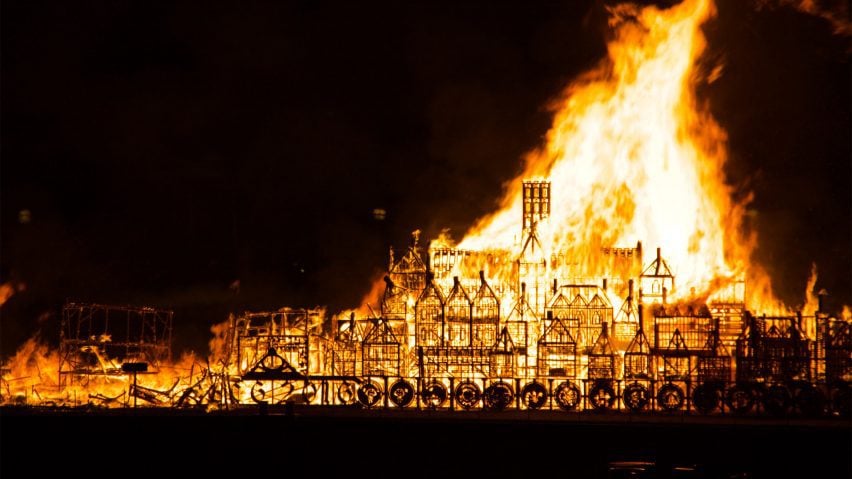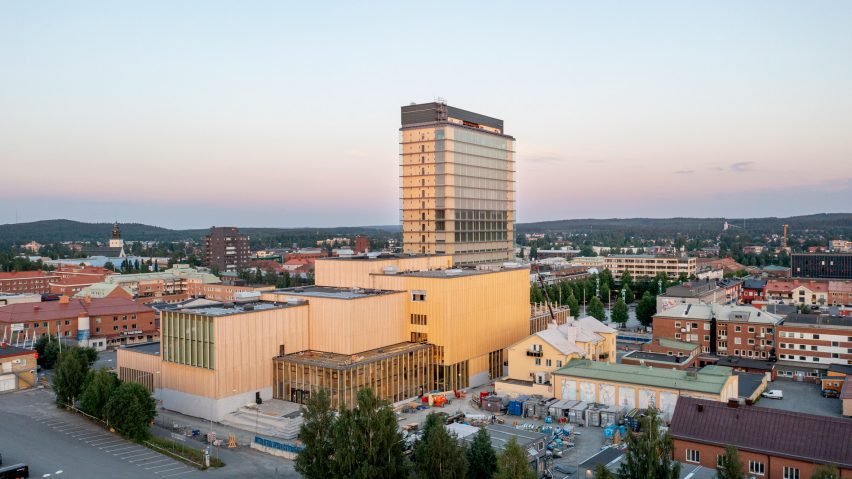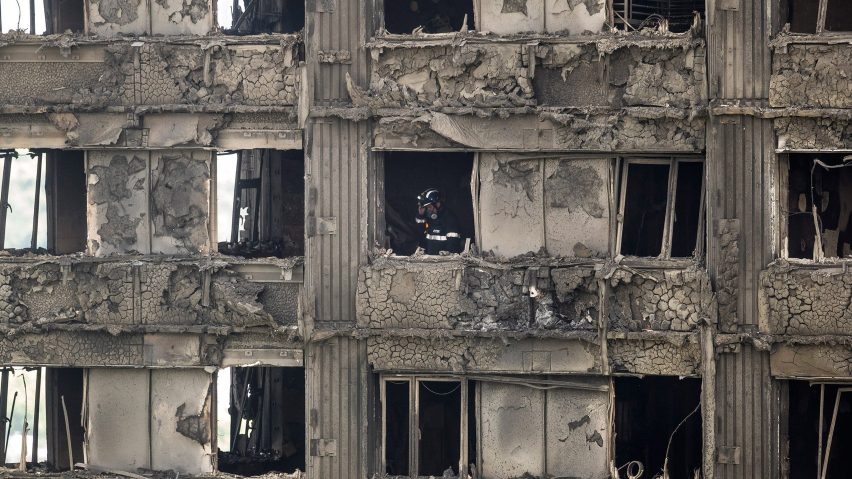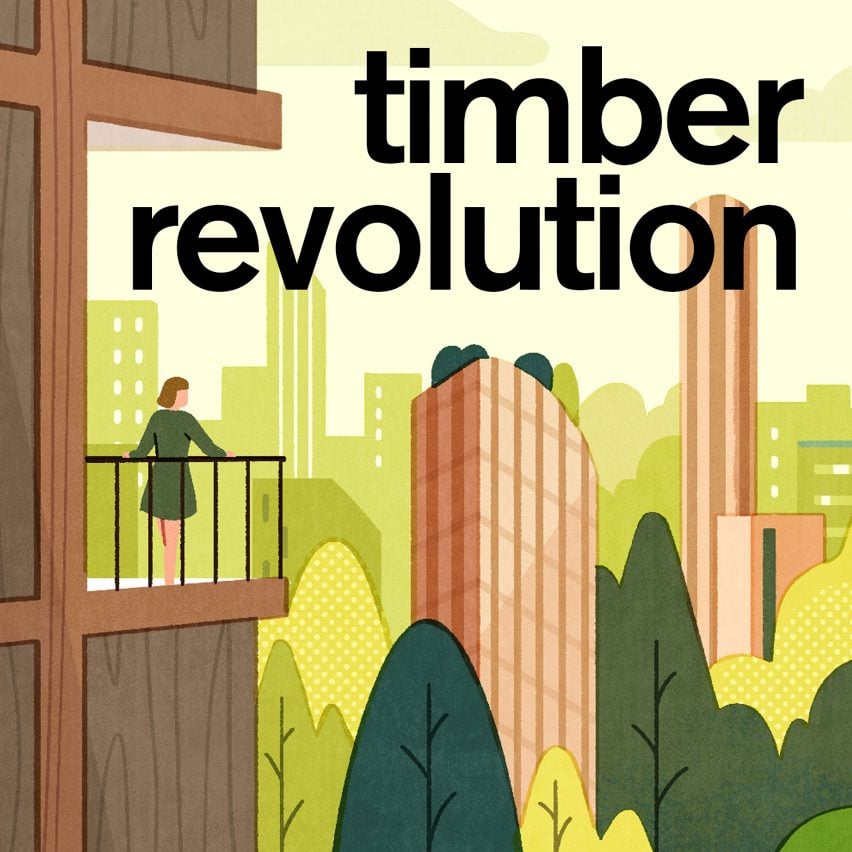
Are mass-timber buildings a fire safety risk?
Architects enthusiastic about mass timber must improve their understanding of fire safety or risk disaster, experts tell Dezeen as part of the Timber Revolution series.
Uncertainty among governments and insurers over whether mid- and high-rise timber buildings are safe in a fire remains a key obstacle to the greater adoption of engineered-wood buildings.
No consensus has been reached across different building code jurisdictions about the safety limitations of building with wood, and the rules vary wildly between countries.
In Finland, the maximum permitted height for a residential building with a load-bearing timber structure and no sprinklers is two storeys. In neighbouring Sweden, there is no limit.
Some countries, including the US, France and Switzerland have recently changed regulations to make building with timber easier, but others – like the UK – have made it tougher.
Fire safety "a problem of competency"
"Timber can be perfectly safe if it's done right," said José Torero, head of the Department of Civil, Environmental and Geomatic Engineering at University College London and a world-leading expert on mass-timber fire safety.
"This is not a technological or technical problem," he told Dezeen. "It is fundamentally a problem of competency."
"The problem is whether [building designers] are competent enough to be able to make a proper assessment, and that is a much, much more complicated question."
While the experts that Dezeen spoke to were unanimous that mass-timber buildings are not inherently unsafe, they also emphasised the importance of knowing the risks.
"It's definitely possible to build timber buildings that meet an adequate level of safety, but you cannot build anything you want without constraints," explained OFR Consultants technical director Danny Hopkin. "You have to address the specific hazards that those buildings present."

Unlike in a steel or concrete building, in a timber building the structure itself is a potential source of fuel.
"There's a feedback between the structure and the fire," explained Rory Hadden, Rushbrook lecturer in fire investigation at the University of Edinburgh.
"With steel and concrete, they're just subject to that fire, whatever the fire might be. So the timber problem is arguably more complex because of that – and that needs to be acknowledged."
Factors like how much timber is exposed and the size of windows and rooms can have a major bearing on how a mass-timber building behaves in a fire.
Meanwhile, the external flames emitting from a burning timber building would be much larger than from a concrete structure, increasing the risk that the fire could spread to surrounding buildings and spark an urban conflagration.
"The ultimate consequences in the case of a timber building can be much more significant than in the case of a concrete or steel building," Torero warned.
"We shouldn't play down the fire safety concerns"
UK networks lead at Built By Nature Joe Giddings is a vocal advocate of mass timber. However, he believes it is important to be up-front about the material's potential hazards.
"The more you learn about fire dynamics in timber buildings, the more you realise how nuanced and complex the issue is," he told Dezeen.
"If we breed false confidence without competency becoming widespread, we're playing a dangerous game. We shouldn't play down the fire safety concerns."
But in the face of overzealous resistance from insurers and regulators, proponents of mass timber can sometimes do exactly that.
"One tendency is the typical enthusiast, who says, 'no, timber self-extinguishes, and it's amazing and it's natural, and we should just build with timber'," said fire safety engineer Carmen Gorska, who has a PhD on fires in engineered-timber structures.
"And it's not exactly like that. It is an amazing material, but we have to know how to design with it."
Fire safety "not prioritised at all"
Torero goes further. "It's not prioritised at all," he said of the fire safety aspect. "And nevertheless, we're moving at a speed that is extraordinary. And to me, that is just a reflection of pure ignorance, and we're entering a space where we are taking risks blindly."
Hadden claims that architects in particular are often complicit, unwilling to engage with the technical discussion.
"Fire safety is a barrier," he said. "The way to get around it is to engage with that barrier. And that's where we've seen, I think, quite a lot of disengagement from some architects."
"I think the architects need to move on and say, 'look timber does burn, and that's obviously something that we've addressed in our design of this building.'"
He is concerned about "the over-simplistic portrayal" of timber's behaviour in fire, especially in relation to charring, which he argues "does massive disservice" to the case for wooden architecture.
When timber burns it forms a char layer, protecting the wood behind the char and helping to reduce the ferocity of the fire.
"Every material has its problems"
But Hadden, Torero and Hopkin agree that this phenomenon is more complex than some mass-timber advocates would have you think.
"That knowledge comes from very specific circumstances in very controlled testing regimes, and in a building fire it's tougher to have great certainty about how it's going to perform," said Hopkin.
Then there is the claim that timber performs better than steel in a fire, frequently made by pro-wood organisations.
"That's such a pointless, bullshit comparison," shot Hadden. "They're just different. Steel has its own problems, timber has its own problems. Every material has its problems, you have to just figure out how you manage that."

Architects should be honest about these nuances, as well as aware of their own limitations in understanding, argues Daniel Asp of White Arkitekter, whose Sara Kulturhus Center is one of the tallest mass-timber buildings in the world.
"I think it's important to know what you know, and know what you don't know, and when you don't know you have to ask the right engineers," he said.
Despite the rapidly increasing interest in mass timber, only a small number of architects and engineers possess extensive knowledge and experience of working with the material.
"The investment in competency is zero"
For Torero, that needs to change fast. He notes that the height of the world's tallest building has already more than doubled in the last decade and is soon set to hit 100 metres in Schmidt Hammer Lassen's Rocket&Tigerli.
"The speed with which we're going is extraordinary, and yet the investment in competency is zero," he said.
Giddings agrees. "We are faced with a really complex challenge: we need to switch really quickly to mass timber but we also need a rapid uptake in knowledge to enable this transition, which isn't happening fast enough at the moment," he said.
Given the misconceptions, should we be concerned about the safety of existing mass-timber buildings?
"I know there are some where I would have concerns about them," said Arup principal David Barber, a specialist in the fire safety of mass-timber structures.
"It would be people who haven't understood what they don't know, people who haven't been experienced enough with mass timber to have spent the time and the effort to actually find out the stuff they don't know."
Potential consequences "can be catastrophic"
The patchy nature of expertise in this area leaves Torero particularly uneasy.
"My concern is that there are no proper standards of competency when it comes to the design of mass-timber buildings," he said. "And the potential consequences that you can have from a fire in a poorly designed building can be catastrophic."
"So in that context, yes, I'm extremely concerned about existing buildings, as much as future buildings that are being built."
Building fires are rare and there are relatively few mass-timber buildings, so the number of real-world examples to support understanding of the potential risks is vanishingly small.
In one such example, a RIBA Award-winning CLT and glulam chemistry building at Nottingham University dubbed "the world's first carbon-neutral lab" was completely destroyed in a fire in 2014 while it was still being constructed.

Construction fires are not necessarily representative of what would happen in a blaze at an occupied building, but Giddings remains concerned.
"What if the next big fire is in a timber building?" he said. "I have given it lots of thought. It definitely worries me."
He draws a comparison with Grenfell Tower in London, where flammable cladding products contributed to the rapid spread of a 2017 fire that killed 72 people.
"I've followed the Grenfell inquiry really closely and if you ignore the type of materials they were talking about, what you are left with is a material lobby seeking to get their materials adopted on a large scale, no matter the consequences – and that should be eye-opening for all of us," he said.
One event could "have a very significant impact on future regulation"
If a fire with serious consequences does hit a mass-timber building, it could spell disaster for the material.
"My concern is one day there'll be a reasonable timber building fire, and that will potentially cause a knee-jerk reaction from a codes and standards point of view," said Barber.
This risk alone should be enough to persuade those eager to design mass-timber buildings to be open about fire, Hopkin argues.
"Post-Grenfell in particular it only takes one event, one incident, to have a very significant impact on future regulation," he said.
"If we continue with this message that it's simple, it's predictable, and not addressing the hazards then we increase the probability of something going wrong, and if that happens mass timber could be very severely restricted – and then you basically remove it as a tool in addressing the climate emergency."
The top photo, showing a reenactment of the 1666 Great Fire of London, is by Rowan Freeman.

Timber Revolution
This article is part of Dezeen's Timber Revolution series, which explores the potential of mass timber and asks whether going back to wood as our primary construction material can lead the world to a more sustainable future.